Alphabet’s AV development subsidiary Waymo has taken the unprecedented step of making its self-driving data set available to the public.
Available for free, the Waymo Open Dataset comprises high-resolution multimodal sensor data covering more than 10 million miles in 25 cities. The data set covers a wide variety of environments, from dense urban centers to suburban landscapes, as well as data collected during day and night, at dawn and dusk, in sunshine and rain.
Believed to be one of the largest self-driving data sets ever released for research, it contains data from 1,000 driving segments, with each segment capturing 20 seconds of continuous driving, corresponding to 200,000 frames at 10Hz per sensor. Such continuous footage gives researchers the opportunity to develop models to track and predict the behavior of other road users.
Each segment contains sensor data from five high-resolution Waymo lidars and five front-and-side-facing cameras. The data set includes lidar frames and images with vehicles, pedestrians, cyclists and signage carefully labeled, capturing a total of 12 million 3D labels and 1.2 million 2D labels. Waymo has also been working on 3D perception models that fuse data from multiple cameras and lidars.
A statement on the company’s blog page read, “When it comes to research in machine learning, having access to data can turn an idea into a real innovation. This data has the potential to help researchers make advances in 2D and 3D perception, and progress on areas such as domain adaptation, scene understanding and behavior prediction. We hope that the research community will generate more exciting directions with our data that will not only help to make self-driving vehicles more capable, but also impact other related fields and applications, such as computer vision and robotics. This release is just the first step and we welcome community feedback on how to make our data set even more impactful in future updates.”


